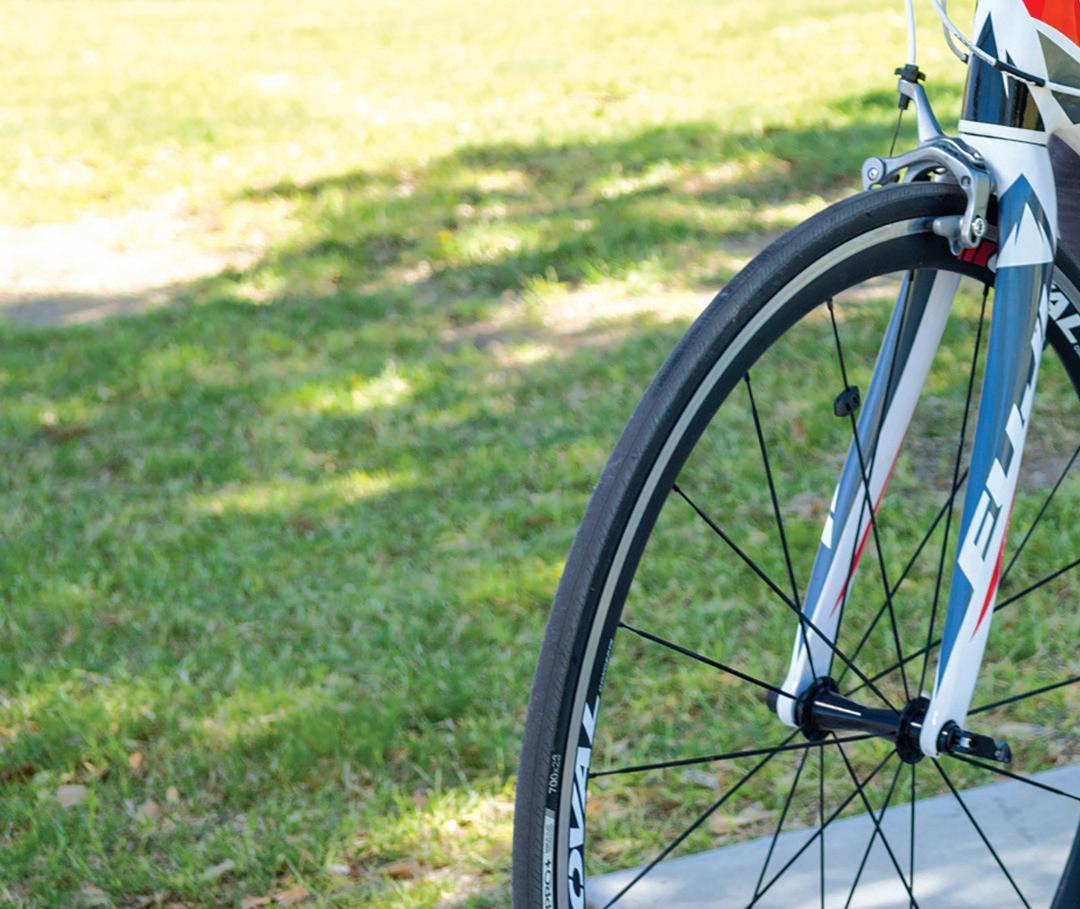
5 minute read
Historic Journey







Fifty-one-year-old bilateral amputee Steve Martin, an Army veteran, plans to ride his bike across the country beginning in mid-May. (Photo by Pablo Robles)

HISTORIC JOURNEY
Bilateral amputee planning to ride bike across United States
BY CHRISTINA FUOCO-KARASINSKI
rmy veteran Steve Martin lost his legs as a result of injuries he sustained from a roadside bomb in Afghanistan. Th e Goodyear resident was a contractor at the time and didn’t qualify for VA benefi ts. He handles it in the best way — he shrugs it off . “I have a great life,” he says. “It’s weird to think that getting wounded creates opportunities. If I didn’t get hurt, I’d just be working. It’s kind of a weird blessing. It created opportunities I wouldn’t have had.”
Beginning in mid-May, the 51-year-old bilateral-below-the-knee amputee, who refuses to allow physical limitations to stop him from achieving his goals, will start pedaling a standard bike with his prosthetic feet and follow the blind Paralympic cyclist Shawn Cheshire on a 4,000-mile journey.
Martin says the ride will be one part fun, one part painful. Th e ride will start in Florence, Oregon, on May 17 and end in Virginia Beach, Virginia, on July 8.
“It’s going to hurt my butt,” he says with a laugh. “It’s a lot of time to sit on a little seat.”
Martin is planning to ride an average of 84 miles per day, with 113 miles scheduled as the longest ride in any single day. He and Cheshire will also veer off the trail to stop at schools for the blind in four states, as well as at police stations and fi re departments. Another stop is at the Ottobock facility in Louisville, Kentucky. Th e company makes prosthetics, orthoses and exoskeletons. Martin says he wants to share his motivation with others who are facing similar limitations in body or mind.
Originally, Cheshire and Martin were going to ride a tandem bike, but the Paralympics committee nixed that idea. When Cheshire, who lives in Florida, stopped competing in 2019, she brought up the trek again.
“We started talking about how fun it would be for two fake legs and a blind girl to ride across the United States,” he says with a laugh. “Th e story writes itself.”
Th ey’re riding their own bikes for 4,000 miles. Th e two and an accompanying rider will wear Bluetooth headsets to guide Cheshire.
“We’re in her ear,” he says. “We’ll tell her we’re coming to a hill, get your gears ready; or there’s a sharp turn coming; or we’re riding in town, don’t run into a parked car. It’s going to be a challenge or 4,000 miles of bad jokes.”
Following in family’s footsteps
Martin, who attended Horizon High School, joined the Army at the end of 1990 and spent six years there.
“I hated college,” Martin says. “I’m the middle of fi ve boys. My brother, who’s the next oldest in age, said we should go in the Army. I went down and enlisted.
“He changed his mind. My dad did three tours of Vietnam. My grandpa was in World War II. It wasn’t really anything I was thinking about, though.”
Aft er the Army, he was with the Arizona Guard until 1999. He returned to the Middle East as a contractor, and in 2008 in Afghanistan he was catastrophically injured.
“I went back over with the State Department, and I was assigned to an Army unit as a civilian adviser,” he says.
“I was out doing a mission and the Humvee was blown up. When you think about it, I trained with the guys. I ate with the guys, the only diff erent was where the pay came from. When you look from the outside in, you couldn’t tell the diff erent. We were all doing the same job.”
Th e stinger was, because he was a contractor, he couldn’t receive VA benefi ts for his injuries — even though he’s a veteran.
“Th ere aren’t a lot of wounded civilians. Th at’s not something people are used to hearing. People get it confused. I was in combat and the bomb didn’t care that I was a civilian. Two of us in the Humvee lost both legs, but all four of us survived.”
Martin tried to save his legs for about a year and a half, but he was content with entering HonorHealth Osborn Medical Center for the surgery to remove them.
“Before, I was told I would never walk again — and have a life of pain, medication and limited mobility,” he says. “I had no chance of doing things I wanted to do. I walked into Osborn and three days later rolled out as a double amputee.
“It wasn’t a hard decision. I knew what I had, and I was willing to take the chance. I was told about phantom pain. Th at quality of life is horrid. It’s a little rough on the brain. It makes things hard. I took a chance, and it’s worked out well. I have a great life.”
As a bilateral amputee, Martin has run 60 half-marathons and 18 full marathons. He has also hiked the Grand Canyon and climbed Mount Kilimanjaro. Professionally, he was the fi rst and only double amputee to serve as a state trooper in Arizona.
“I plan to get every mile and every minute out of my body,” Martin says. “I want to be active. I want to run my life. I want to show the world that losing my legs may have altered my path, but it did not stop me.”










